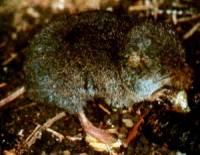Sorex Fumeus on:
[Wikipedia]
[Google]
[Amazon]
The smoky shrew (''Sorex fumeus'') is a medium-sized 
North America
North America is a continent in the Northern Hemisphere and almost entirely within the Western Hemisphere. It is bordered to the north by the Arctic Ocean, to the east by the Atlantic Ocean, to the southeast by South America and the Car ...
n shrew
Shrews (family Soricidae) are small mole-like mammals classified in the order Eulipotyphla. True shrews are not to be confused with treeshrews, otter shrews, elephant shrews, West Indies shrews, or marsupial shrews, which belong to different fa ...
found in eastern Canada
Canada is a country in North America. Its ten provinces and three territories extend from the Atlantic Ocean to the Pacific Ocean and northward into the Arctic Ocean, covering over , making it the world's second-largest country by tot ...
and the northeastern United States
The United States of America (U.S.A. or USA), commonly known as the United States (U.S. or US) or America, is a country primarily located in North America. It consists of 50 states, a federal district, five major unincorporated territorie ...
and extends further south along the Appalachian Mountains
The Appalachian Mountains, often called the Appalachians, (french: Appalaches), are a system of mountains in eastern to northeastern North America. The Appalachians first formed roughly 480 million years ago during the Ordovician Period. They ...
.

Subspecies
This species has two recognized subspecies: *''Sorex fumeus fumeus'' *''Sorex fumeus umbrosus''Description
The smoky shrew is active year-round. It is dull grey in colour with lighter underparts and a long tail which is brown on top and yellowish underneath. During winter, its fur is grey. Its body is about in length including a long tail and it weighs about .Habitat and ecology
This animal is found near streams in cool damp deciduous and mixed woods. It makes extensive, solitary, burrows in the leaf litter on the forest floor or builds globular nests of plant materials under rocks. The smoky shrew rarely digs tunnels, instead it uses tunnels created by moles or other shrews. Its diet consists mainly of beetles, however other insects, earthworms, snails, small rodents and other soil dwelling invertebrates are also taken. It also consumes plant material to supplement its diet. Predators include owls, snakes, foxes, weasels, and mustelids.Reproduction
Smoky shrews start mating in late March, and females give birth to their first litters in April or May, about 20 days after mating. They mate again as soon as the first litter is born, and they may have 2 more litters, each about a month apart, if the female lives long enough. Each litter has 2 to 8 pups, usually 6. In one month, the offspring weigh around 4 grams which is half of the adult weight. Male smoky shrews don't take care of their offspring, only the female does. Females make nests in leaf litter where they give birth. The offspring are blind, helpless, and have no fur. Females nurse and protect their offspring for a short time (less than 20 days).Social behavior
No information exists about the social organization of the smoky shrew. Some field biologists, noting the abundance of the species in some areas and its absence in others, have suggested the smoky shrew is colonial. However, their data remain inconclusive, and may reflect a tendency for smoky shrews to achieve dense populations within pockets of suitable habitat instead of exhibiting a complex social structure Smoky shrews are quite vocal although the form and function of the vocal repertoire are not well known. Individuals "twitter" while foraging, and give high-pitched grating noises when alarmed.References
*"Smoky Shrew (Sorex Fumeus Miller)." Smoky Shrew. N.p., n.d. Web. 07 Apr. 2015. * * * Sorex Mammals described in 1895 {{redtoothed-shrew-stub